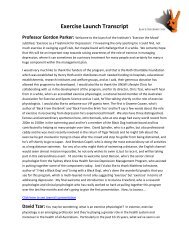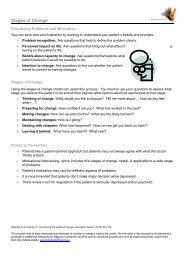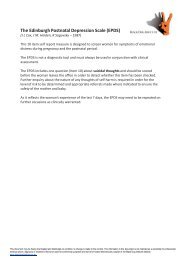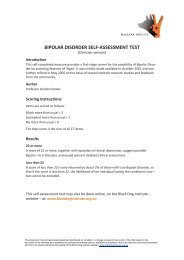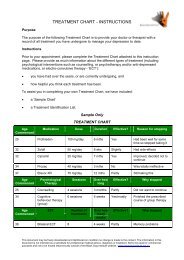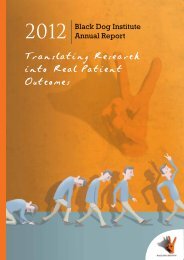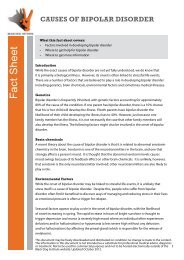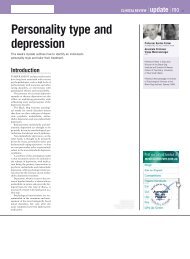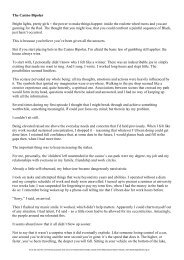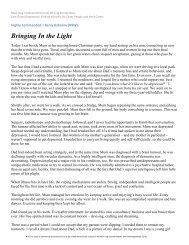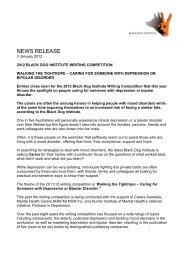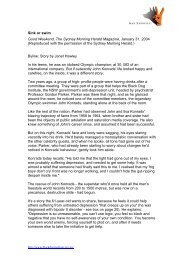T&P Questionnaire - Black Dog Institute
T&P Questionnaire - Black Dog Institute
T&P Questionnaire - Black Dog Institute
Create successful ePaper yourself
Turn your PDF publications into a flip-book with our unique Google optimized e-Paper software.
TEMPERAMENT & PERSONALITY (T&P) QUESTIONNAIRE INFORMATION<br />
Part 1: Introduction to the Temperament and Personality <strong>Questionnaire</strong><br />
Subjects are required to rate each item on the questionnaire according to how they generally feel or<br />
behave; not necessarily as they are when depressed. Clinical evidence suggests that all but the most<br />
profoundly depressed are able to complete this 109-item questionnaire within 20 minutes.<br />
The T & P <strong>Questionnaire</strong> is available for use free of charge. It can be completed in a pen-and-paper format<br />
and scored using the guide provided in this document. Alternatively, the T & P <strong>Questionnaire</strong> can be<br />
completed online on the <strong>Black</strong> <strong>Dog</strong> <strong>Institute</strong> website (www.blackdoginstitute.org.au), in which case<br />
personality scale scores will be automatically computed and reported along with descriptions of the scales.<br />
Scales of the T & P <strong>Questionnaire</strong>:<br />
In developing items for the questionnaire, we included personality constructs from literature reviews<br />
and/or seemingly over-represented constructs observed in depressed patients in clinical practice. The final<br />
version of the T&P questionnaire comprises 10 subscales – 8 of which assess temperament and personality<br />
(89 items) and two of which refer to personality function (Cooperativeness: 10 items; Effectiveness: 10<br />
items). The scales assessed by the measure are:<br />
Personality dimensions<br />
Anxious Worrying<br />
Personal Reserve<br />
Perfectionism<br />
Irritability<br />
Social Avoidance<br />
Interpersonal Sensitivity<br />
Self-criticism<br />
Self-focused<br />
Personality functioning dimensions<br />
Cooperativeness<br />
Effectiveness<br />
1<br />
This document may be freely downloaded and distributed on condition no change is made to the content. The information in this document is not intended as a substitute for<br />
professional medical advice, diagnosis or treatment. Not to be used for commercial purposes and not to be hosted electronically outside of the <strong>Black</strong> <strong>Dog</strong> <strong>Institute</strong> website.<br />
www.blackdoginstitute.org.au
Part 2: Scoring the Temperament and Personality <strong>Questionnaire</strong><br />
Note: Although the temperament and personality scale scores utilize only 61 items, clinicians and researchers<br />
are encouraged to collect data on all 109 items as ongoing statistical analyses by the authors that will be made<br />
available over our website, may yield other useful information regarding the structure and function of this<br />
measure. If any substantive changes are made to the instrument or its scoring in the future, they will be<br />
recorded on the <strong>Black</strong> <strong>Dog</strong> <strong>Institute</strong> website.<br />
Each item on the questionnaire is rated on a 4-point scale where:<br />
Very true = 3 (0 for reverse scored items indicated by ‘R’)<br />
Moderately true = 2 (1 for reverse scored items)<br />
Slightly true = 1 (2 for reverse scored items)<br />
Not true at all = 0 (3 for reverse scored items)<br />
Table 2, on the following page, describes the questionnaire items which correspond to each personality<br />
scale at each tier. Note that some of the items are reverse scored (indicated by ‘R’). Item numbers for the<br />
two personality function scales are provided in Table 1.<br />
The following is the guide for scoring the T&P questionnaire.<br />
Step 1: Reverse score the following items – 1, 2, 12, 21, 25, 27, 36, 39, 49, 50, 71, 77, 82, 92 and 103<br />
Step 2: Compute scale scores by summing the items for each dimension – see Table 1.<br />
Step 3: Compute scale scores for Cooperativeness and Effectiveness – see Table 2.<br />
Table 1. Items numbers on the T & P <strong>Questionnaire</strong> for all personality dimensions.<br />
Anxious Worrying 41, 53, 62, 65, 69, 75, 79, 106<br />
Personal Reserve 8, 9, 18, 24, 30, 45, 60, 94<br />
Perfectionism 4 , 16, 29, 46, 47, 64, 66, 68<br />
Irritability 7, 13, 17, 35, 55, 61, 105, 107<br />
Social Avoidance 2R, 39R, 49R, 50R, 57, 71R, 85<br />
Interpersonal Sensitivity 22, 42, 56, 63, 70, 78, 96<br />
Self-criticism<br />
32, 34, 52, 58, 72, 77R, 82R, 103R<br />
Self-focused 19, 33, 43, 48, 67, 76, 80<br />
Table 2. Item numbers on the T & P <strong>Questionnaire</strong> for the two personality functioning scales.<br />
Cooperativeness 3, 5, 12R, 21R, 26, 59, 89, 97, 100, 108<br />
Effectiveness 23, 25R, 27R, 36R, 38, 51R, 88, 92R, 95, 109<br />
2<br />
This document may be freely downloaded and distributed on condition no change is made to the content. The information in this document is not intended as a substitute for<br />
professional medical advice, diagnosis or treatment. Not to be used for commercial purposes and not to be hosted electronically outside of the <strong>Black</strong> <strong>Dog</strong> <strong>Institute</strong> website.<br />
www.blackdoginstitute.org.au
Part 3: Interpreting the Temperament and Personality <strong>Questionnaire</strong><br />
‘Cut-off’ scores<br />
The ‘cut-off’ scores reported in the descriptions below are based on scores in a Community Sample of 529<br />
people attending a general practitioner in Sydney. ‘High’ scores are one standard deviation above the<br />
mean in this sample, and ‘low’ scores are one standard deviation below the mean in this sample.<br />
Association with depression<br />
Where relevant, the potential association between each of the personality dimensions and depression is<br />
also described. This is based on:<br />
i) Average scores amongst people experiencing depression (Depressed Sample) compared to those in a<br />
general Community Sample.<br />
ii) Our clinical experience at the <strong>Black</strong> <strong>Dog</strong> <strong>Institute</strong> Depression Clinic.<br />
However, it is important to note that the influence of personality on depression is usually due to an<br />
interaction between life events and personality, not personality alone, and that there are other factors<br />
involved. Therefore, a high score on any of the scales below does NOT mean that depression is inevitable.<br />
Rather, it can be useful to identify the role of personality in an individual’s episode of depression because<br />
such characteristics (e.g. worrying, social avoidance) can be addressed with the help of a mental health<br />
professional, in order to treat the depression most effectively.<br />
Personality dimensions<br />
1. Anxious Worrying<br />
High scores on this scale (18 and over, out of a maximum of 27) indicate a greater tendency to become<br />
stressed, worried and anxious. Examples of items from this scale include ‘I tend to stress easily’ and ‘I’m<br />
inclined to worry over quite minor things’.<br />
Scores on this scale are higher (on average) amongst people who are currently depressed compared to<br />
those from a general community sample. In our clinical experience, excessive worrying, if unaddressed,<br />
may increase the risk of developing depression. When under stress, people high on the anxious worrying<br />
scale may have catastrophic thoughts (i.e. think that the worst will happen) or feel overwhelmed.<br />
2. Personal Reserve<br />
High scores (17 and over, out of a maximum of 27) are associated with a tendency to keep one’s inner<br />
feelings to oneself. People high on the personal reserve scale tend to be reluctant to let friends and<br />
acquaintances get to know them too well. Examples of items from this scale include ‘I prefer not to get too<br />
close to people’ and ‘Opening up to people makes me feel uneasy’.<br />
Scores on this scale are higher (on average) amongst people who are currently depressed compared to<br />
those from a general community sample. In our clinical experience, high levels of personal reserve may<br />
increase the risk of developing depression following events that challenge concerns about closeness (e.g.<br />
difficulties in relationships). People high on the personal reserve scale may find it more difficult than<br />
others to ask for help when experiencing depression.<br />
3. Perfectionism<br />
High scores (31 and over, out of a maximum of 33) are associated with a tendency to be very responsible,<br />
to have high standards for oneself and to be highly committed to tasks and duties. Items in this scale<br />
include ‘I always like to do my best’ and ‘I put high standards on myself and most things I take on’.<br />
Scores on this scale do not differ (on average) between those who are currently depressed and a general<br />
community sample. However, while perfectionism can be a helpful characteristic, when extremely high it<br />
3<br />
This document may be freely downloaded and distributed on condition no change is made to the content. The information in this document is not intended as a substitute for<br />
professional medical advice, diagnosis or treatment. Not to be used for commercial purposes and not to be hosted electronically outside of the <strong>Black</strong> <strong>Dog</strong> <strong>Institute</strong> website.<br />
www.blackdoginstitute.org.au
can actually interfere with daily life. In our clinical experience, certain events can trigger depression in<br />
people with very high perfectionism. These stressful events tend to involve not being able to live up to very<br />
high standards that one has set for oneself (e.g. not doing as well at work as desired) or the feeling that<br />
one’s pride has been hurt. People high on perfectionism may be reluctant to seek professional help for<br />
depression.<br />
4. Irritability<br />
High scores (21 and over, out of a maximum of 33) are associated with a tendency to be quick-tempered<br />
and to externalise stress by becoming snappy and irritated by little things. Items in this scale include ‘I tend<br />
to get angry and lose my cool when stressed’.<br />
Scores on this scale are somewhat higher (on average) amongst people who are currently depressed,<br />
compared to a general community sample. In our clinical experience, people high on irritability may have<br />
an increased risk to brief episodes of depression. Often people high on irritability may only be cranky or<br />
grumpy when stressed, and later feel remorseful about this.<br />
5. Social Avoidance<br />
High scores on this scale (17 and over, out of a maximum of 27) are associated with a tendency to be<br />
introverted and to keep to oneself, while those low on this dimension tend to be very sociable. Examples<br />
of items in this scale include ‘I tend to be quiet when I’m with people’ and ‘I’m very reserved at parties and<br />
other social situations’.<br />
Scores on this scale are somewhat higher (on average) amongst people who are currently depressed,<br />
compared to a general community sample. Our clinical experience suggests that very high social<br />
avoidance, if unaddressed by treatment, may increase the risk to depression. People who are reserved and<br />
highly socially avoidant are more likely to feel that others have judged them in a negative way, and<br />
therefore may be more likely to feel distressed following social situations.<br />
6. Interpersonal Sensitivity<br />
High scores (14 and over, out of a maximum of 24) are associated with a tendency to worry about rejection<br />
or abandonment. Items in this scale include ‘I fear that my important relationships will end somehow’ and<br />
‘I think a lot about being deserted by loved ones’.<br />
Scores on this scale are higher (on average) amongst people who are currently depressed, compared to a<br />
general community sample. Our clinical experience suggests that feeling rejected in an important<br />
relationship is a common trigger for depression amongst people with high interpersonal sensitivity.<br />
7. Self-criticism<br />
High scores (10 and over, out of a maximum of 12) are associated with a tendency to be very tough on<br />
oneself. Examples of items in this scale include ‘I have always been very self-critical’ and ‘I’m always letting<br />
myself down’.<br />
Scores on this scale are higher (on average) amongst people who are currently depressed, compared to a<br />
general community sample. In our experience, an ongoing style of self-blame and self-criticism can<br />
increase the risk of developing depression. However, it is important to note that most people become<br />
more self-critical when they are depressed. Thus for people who are currently depressed, a high score on<br />
this scale does not necessarily indicate an ongoing style of self-criticism.<br />
4<br />
This document may be freely downloaded and distributed on condition no change is made to the content. The information in this document is not intended as a substitute for<br />
professional medical advice, diagnosis or treatment. Not to be used for commercial purposes and not to be hosted electronically outside of the <strong>Black</strong> <strong>Dog</strong> <strong>Institute</strong> website.<br />
www.blackdoginstitute.org.au
8. Self-focus<br />
High scores (9 and over, out of a maximum of 24) are associated with a tendency to prioritise one’s own<br />
needs over the needs of others. Items in this scale include ‘I get out of lots of problems by blaming other<br />
people’ and ‘I will often take advantage of other’s limitations’.<br />
Scores on this scale do not differ (on average) between those who are currently depressed and a general<br />
community sample. However, in our clinical experience, people high on the ‘self-focus’ dimension can be<br />
more likely to develop depression when their needs are not met. However, these depressive episodes<br />
tend to be relatively brief, often because the individual externalizes their frustration.<br />
Personality functioning dimensions<br />
1. Cooperativeness<br />
Average to high scores (20 and over, out of a maximum of 30) are associated with a tendency to be<br />
generally helpful, compassionate, and empathic and to get along well with others. Examples of items in<br />
this scale include ‘Friends see me as cooperative and agreeable’ and ‘I tend to be very understanding of<br />
other people’s feelings and problems’.<br />
Scores on this scale do not differ (on average) between those who are currently depressed and a general<br />
community sample.<br />
2. Effectiveness<br />
Average to high scores on this scale (18 and over, out of a maximum of 30) indicate an ability to cope well<br />
with different situations and to be confident in problem solving. Items in this scale include ‘I’m really<br />
resourceful in tackling problems’ and ‘I feel confident in my ability to size up and deal with any situation’.<br />
Scores in this scale are lower (on average) amongst those who are currently depressed, compared to a<br />
general community sample.<br />
5<br />
This document may be freely downloaded and distributed on condition no change is made to the content. The information in this document is not intended as a substitute for<br />
professional medical advice, diagnosis or treatment. Not to be used for commercial purposes and not to be hosted electronically outside of the <strong>Black</strong> <strong>Dog</strong> <strong>Institute</strong> website.<br />
www.blackdoginstitute.org.au
Part 4: Publications using the T & P <strong>Questionnaire</strong><br />
Parker, G. & Manicavasagar, M. (2005). Modelling and managing the depressive disorders: A clinical guide.<br />
New York, NY: Cambridge University Press.<br />
Parker, G., Manicavasagar, M., Crawford, J., Tully, L., & Gladstone, G. (2006). Assessing personality traits<br />
associated with depression: the utility of a tiered model. Psychological Medicine 36, 1131-1139.<br />
Parker, G., & Crawford, J. (2007). A spectrum model for depressive conditions: Extrapolation of the atypical<br />
depression prototype. Journal of Affective Disorders 103, 155-163.<br />
Parker, G., & Crawford, J. (2007a). Chocolate craving when depressed: a personality marker. British Journal<br />
of Psychiatry 191, 351-352.<br />
Parker, G., & Crawford, J. (2009). Personality and self-reported treatment effectiveness in depression.<br />
Australian & New Zealand Journal of Psychiatry 43, 518-525.<br />
Rubino, A., Zanasi, M., Robone, C., & Siracusano, A. (2009). Personality differences between depressed<br />
melancholic and non-melancholic inpatients. Australian & New Zealand Journal of Psychiatry, 43, 145-148.<br />
Parker, G., Fletcher, K., Barrett, M., Synnott, H., Breakspear, M., Rees, A. M., et al. (2010). Inching toward<br />
Bethlehem: Mapping melancholia. Journal of Affective Disorders, 123, 291-298.<br />
*Online version of the Temperament and Personality <strong>Questionnaire</strong> available on the <strong>Black</strong> <strong>Dog</strong> website.<br />
The score is calculated automatically.<br />
http://www.blackdoginstitute.org.au/surveys/Temperament/index.html<br />
6<br />
This document may be freely downloaded and distributed on condition no change is made to the content. The information in this document is not intended as a substitute for<br />
professional medical advice, diagnosis or treatment. Not to be used for commercial purposes and not to be hosted electronically outside of the <strong>Black</strong> <strong>Dog</strong> <strong>Institute</strong> website.<br />
www.blackdoginstitute.org.au



